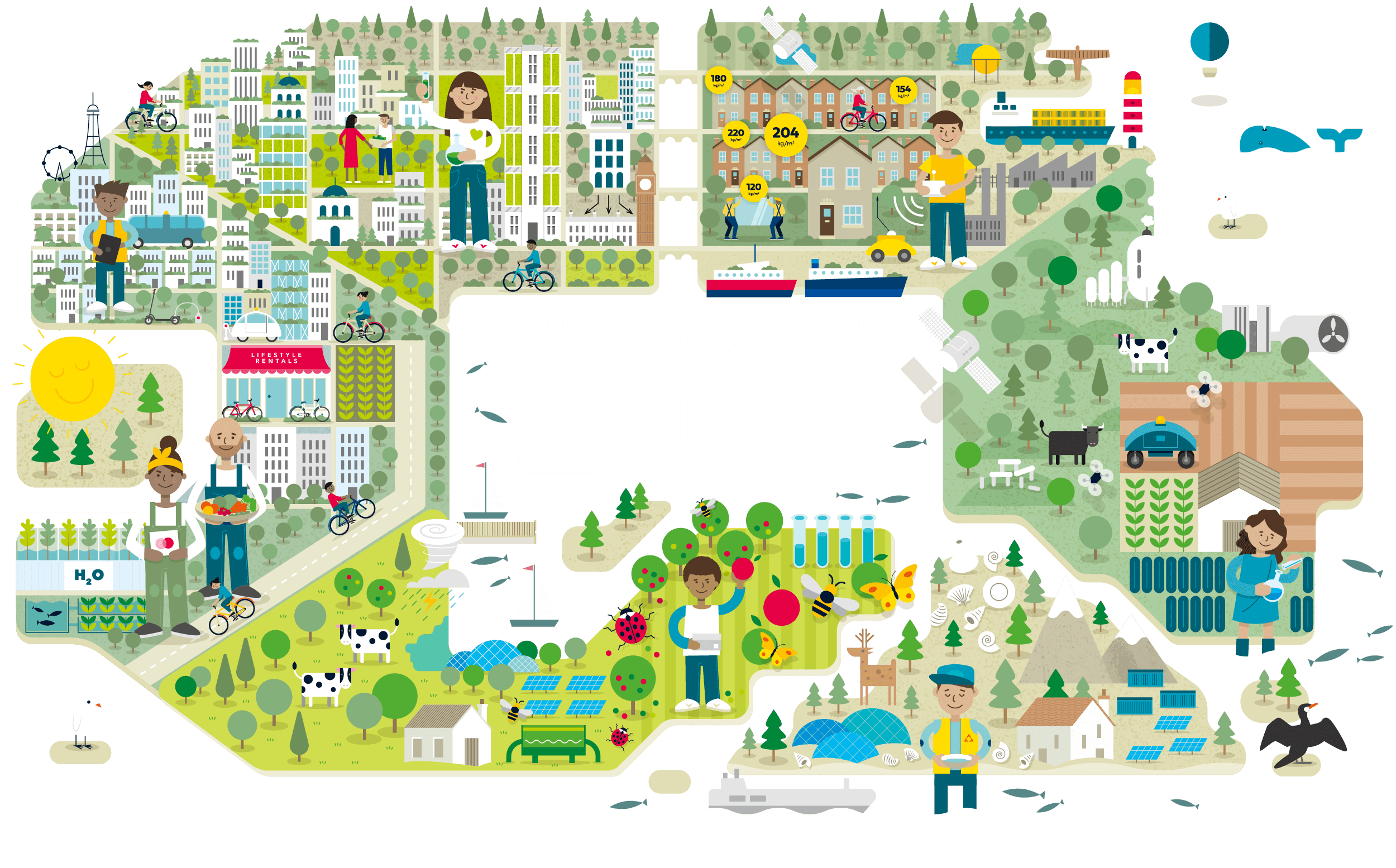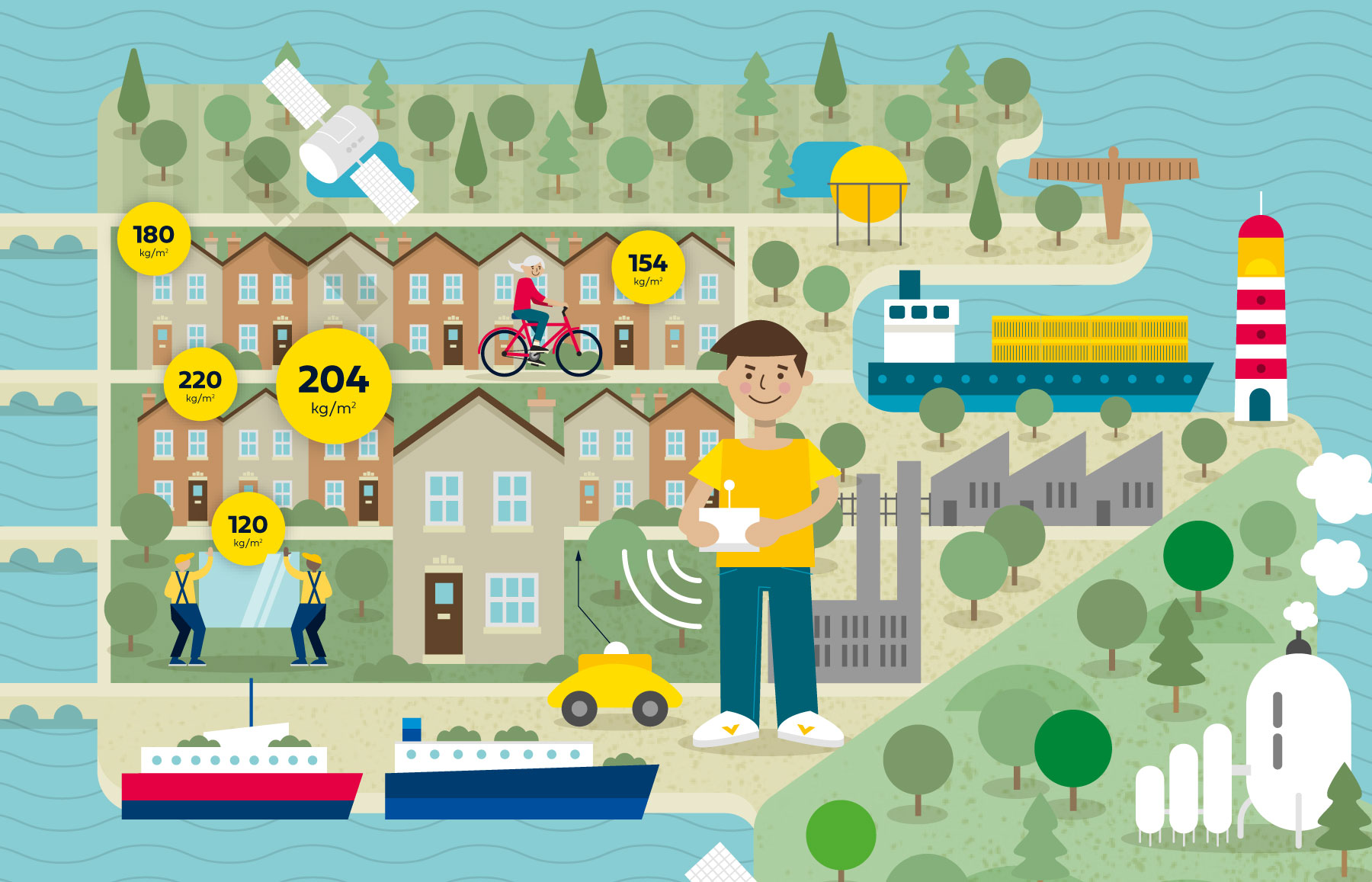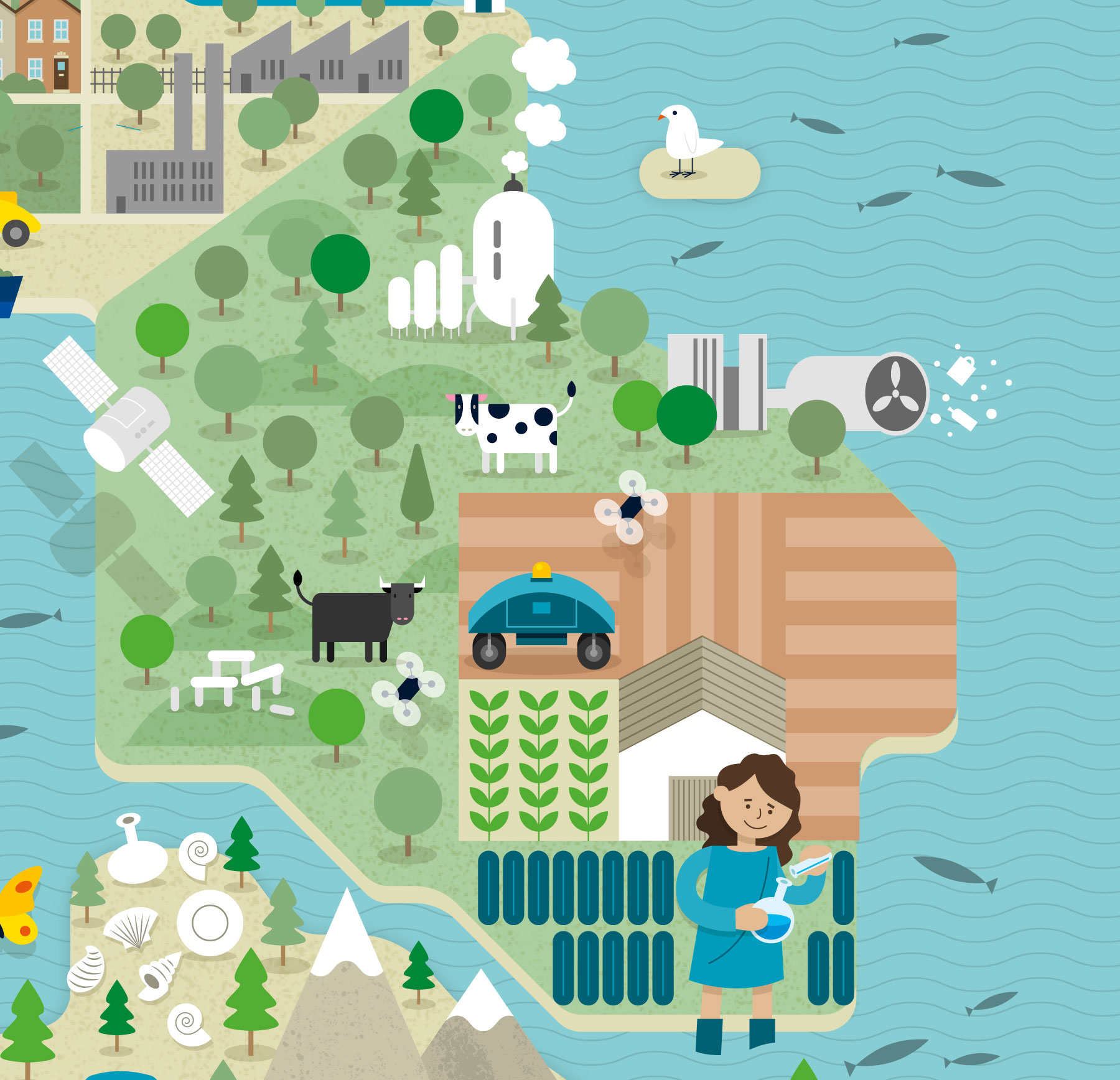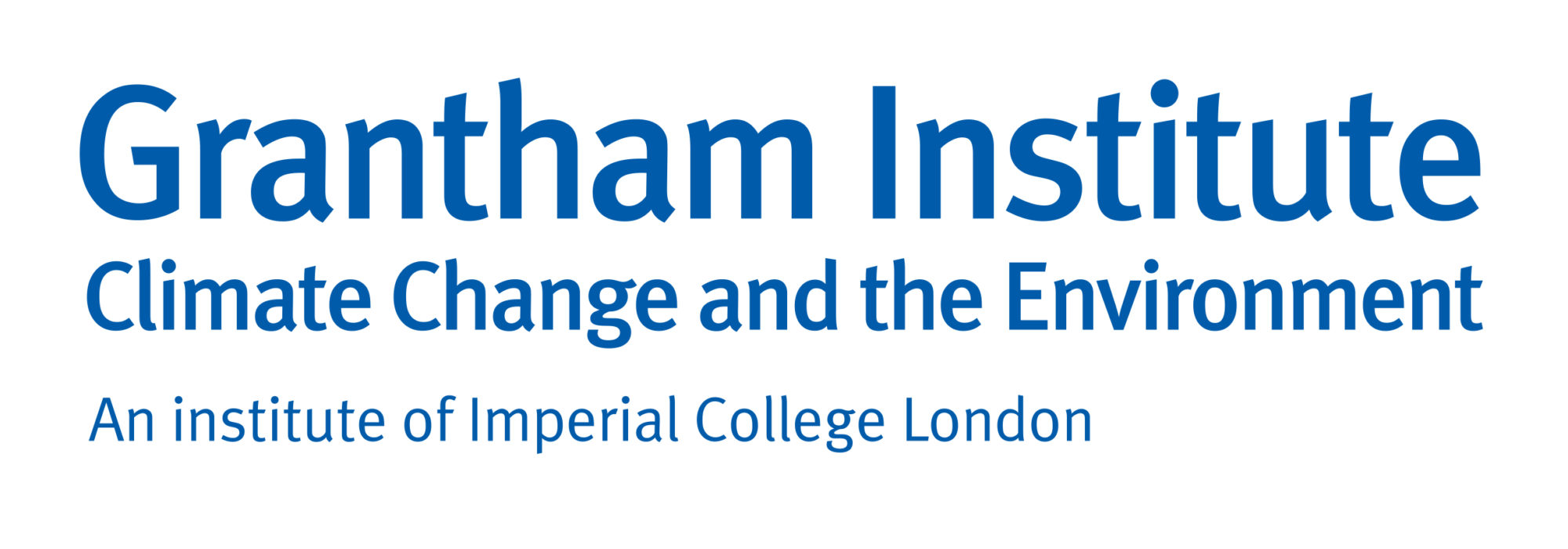
Retrofitting – New advances will give old technology a new lease of life.
Housing – Self-aware buildings will respond to their environment.
Transport – Rush hour is a thing of the past. These streets were made for walking.
Food – Everything is fresh and local. Nothing is wasted.
Agriculture – Vastly different from today, farming is packed with advanced technologies.
Waste – Everything is recycled. New materials are only used when absolutely necessary.
Seagriculture – Marine areas are protected, productive and pollution-free.
What might the world look like in 2050?
A lot can happen in 30 years. Life today looks very different from how it was in 1990. Back then, cheap short-haul flights were rare, and the smart phone was still nearly two decades away; there were only four TV channels, and Google, Amazon and Facebook didn’t exist.
Technology has revolutionised how we live today. But, the planet is under extreme pressure. Humanity is having a devastating impact on the natural world, fuelling dangerous levels of climate change, more turbulent weather and destroying biodiversity. Most recently, the COVID-19 pandemic impacted us all in unprecedented ways. We are at a crossroads and our choices today will define our future.
So, in 30 years time, what kind of world might we be living in?
Right now, inventors and entrepreneurs at Imperial College London are developing world-changing ideas that could transform our relationship with the planet. For over ten years, the Grantham Institute has supported students, researchers, business and startups to transform bright ideas into useable products that both create prosperity and help tackle climate change. Here is our vision, inspired by their work, for a cleaner, greener, fairer future for us all.
Healthy, productive,
self-sufficient cities
Retrofitting
Retrofitting is smart,
cost-effective, and green
George has just moved into a building constructed in 2010, which he knows is not the most efficient house. However, he has received detailed advice from retrofit specialists that use satellite mapping technology to identify how homes can be made more efficient and environmentally friendly.
They have given him heatmaps that show where the building is leaking heat, so he uses a specialist robot to go underneath floors and inside walls to install insulation. The insulation material is made of waste feathers from poultry farms, which previously would have been incinerated. George also replaces the windows with a new material that looks like glass, but is made from waste carbon dioxide emitted by power stations. As a result, his house has become a way to store carbon and recycled local waste materials – and he hasn’t needed to transport expensive building materials across the world. Virgin materials are now very rarely used to build new buildings or structures.
Around 95% of houses have been retrofitted already, and it is quite rare to find a house like George’s. He is keen to carry out the work as each building has a “carbon capture score” and climate certification. These scores measure a building’s impact on the climate and surrounding environment – and a high score will add a lot of value to the property.
Inspired by Rezatec,Q-bot, Aeropowder and Econic Technologies

Satellites use mapping technology to identify how homes can be made environmentally friendly.
Buildings have climate certification scores to measures their impact on the environment.
Building supplies are made from recycled materials. These windows are made from waste carbon dioxide.
Specialist robots install insulation inside walls and under floors.
Housing
Self-aware buildings generate electricity, clean the air and respond to their environment

Buildings use artificial photosynthesis technology to reduce carbon emissions and clean the air.
Algae-production systems produce healthy food ingredients and generate oxygen.
Roofs are fitted with solar-thermal cells to generate electricity and heat.
Laila is the building manager of a multi-purpose building that both generates energy and produces food. She administers the algae-production system, in which microscopic plants produce healthy food ingredients, generate oxygen and store large amounts of carbon dioxide. Artificial photosynthesis technology like this has made buildings into carbon capture and storage devices. These urban forests both reduce carbon emissions and scrub pollutants from the air, helping to make cities cleaner and healthier.
Buildings like this also generate their own renewable energy. Roofs are fitted with solar-thermal cells to generate power and heat that, in conjunction with advanced battery technology and micro-grids, is evenly shared around local communities depending on demand. This system also creates extra income for residents, who are able to trade any excess energy.
Laila also controls the building’s smart technology, which makes it responsive to the environment. This involves managing light-activated coatings on the windows that purify pollutants from the air. Health and wellbeing are at the forefront inside the building too. Every building is fitted with specialist water filters to ensure all water is purified from any potentially harmful chemicals.
Inspired by Arborea, Puraffinity and Naked Energy
Transport
Transport is anticipatory and healthy
Samad is an urban sustainability steward. He uses carbon analytics to calculate the best interventions for city life. He and his team have created digital replicas for urban areas, which allow local governments to test and plan sustainable local adjustments in the city. As a result, healthy, low-carbon living is at the forefront of urban planning, and green space has been prioritised.
Rush hour traffic is a thing of the past. People have more flexible living-working situations, and the streets are designed for walking and cycling to encourage active lifestyles and improve air quality. Samad helped to develop City Mobility Contracts, which allow individuals to rent smart, multimodal transport when necessary. Drones and underground robotics are used to transport supplies and products, further reducing traffic. This has helped people to feel safer on the roads, and led to a shift to e-scooters and e-bikes that can microcharge themselves when necessary.
For longer journeys, people use autonomous electric vehicles powered by long-life batteries. They are charged using electricity generated by local buildings that are connected to an adaptive, flexible electric charging network. These charging stations are stored underground when not in use and are deployed using advanced mapping and sensing technologies only when they are required.
Inspired by Urban Electric Network, Pelation and Carbon Analytics.

Autonomous electric vehicles are powered by long-life batteries which allow for long-distance travel.
Charging stations are stored underground and only deployed when they are required.
E-scooters and e-bikes micro-charge themselves on the grid when needed.
Food
Food is fresh, local and never wasted
Irie and Billy manage a grocery hub. Everything they sell has been grown locally because they have partnered with aquaponic farms. These farms have been integrated into neighbouring buildings and underground areas, allowing people to produce fish and vegetables at scale in city centres. These new agricultural practices feed the cities. It means Irie and Billy don’t have to rely on products supplied by large food corporations. Instead, the supply chain is local, and flexible to their needs.
They store their food using algae-based packaging that biodegrades after use. In addition, accurate sensors on the packaging and external devices make it easy for people to assess how fresh food is. As a result, plastic packaging and “use-by” dates have completely disappeared. Part of Irie and Billy’s job is to eliminate food waste. These innovations allow them allow them to manage an exchange system to ensure all food is sold or exchanged before it is spoiled. For any residual waste, they work closely with a construction company that repurposes food waste to develop new materials for urban buildings.
Inspired by Growup Urban Farms, Mimica and NotPla

The distance between food production and supermarkets is shorter than ever before.
Algae-based packaging has sensors that accurately assess how fresh food is, helping to eliminate food waste.
Aquaponic farms produce fish and vegetables at scale in city centres.
Biodiverse, balanced rural and
coastal areas
Agriculture
Farming is advanced and precise
Kofi manages an apple orchard. He uses advanced technologies to detect precise levels of nutrients in the soil. This allows him to monitor any shifts in its microbial content and take action to ensure the health of the soil is improving over time. He has now managed to stop soil erosion and restore barren fields to fertile land. Such close observation of the ground has also helped him predict and prevent any increases in pests such as apple aphids and caterpillars.
Alongside this, Kofi focuses on the balance of the ecosystem by encouraging rewilding around his apple stock. As a result, he has significantly increased the number of insect pollinators. These regenerative approaches have allowed him to create a completely holistic approach to farming, making a positive impact on the land around him. This is considered an essential ecosystem service, and he is well paid for investing in the land in this way.
While the health of the soil has improved, unpredictable weather still poses challenges for Kofi. To ensure he has a fresh water supply during warmer summers, he uses solar-thermal desalination technology to purify seawater using just sunlight. He also carries out microclimate analyses, allowing him to anticipate local weather shifts that could impact his orchard. He recently planted new apple strains that have been ‘climate-adapted’ and are more resilient to turbulent weather. He has even worked with laboratories to bring back hereditary seeds that had been extinct from the UK for about 100 years. This has allowed him to improve the diversity and resilience of his apple stock.
Inspired by Rezatec, PES Technologies, Climate Edge, Phytoform Labs, Desolenator and Lixea

‘Climate-adapted’ crops are more resilient to turbulent weather.
For fresh water all summer long, solar-thermal desalination technology purifies seawater using sunlight.
Rewilding and regenerative farming boost the number of insect pollinators and improves biodiversity.
Waste
Waste is wealth

Houses are equipped advanced technology that converts solar energy to hydrogen power, which residents trade with autonomous ships that pass by.
Waste materials are always reused – these shells from fishing companies are repurposed into kitchenware.
Andrew is a circularity steward and waste advisor for his local area. His role involves managing waste materials and how they are re-purposed. New materials are only used when absolutely necessary, and organisations have to be fully transparent about where they source their products, so he is in high demand. For one of his clients, he manages the collection of shells from fishing companies and redistributes them to regional centres that repurpose them into kitchenware. For another, he manages the conversion of farm waste to bio-composite building materials.
Houses are also equipped with the latest renewable technology and connected to micro-grids. This allows residents to trade surplus energy so they can profit from every ray of sunlight. Advanced technology also enables them to convert solar energy to hydrogen power, which they can store in case there is any disruption to electricity supply, and trade with the autonomous ships that pass by coastal areas.
Inspired by Shellworks, Cambond, Adaptavate, Solaris OffGrid and H2GO power
Seagriculture
Marine areas are protected, productive and pollution-free
Michelle works in seagriculture, managing the production and use of seaweed, which has surged in popularity due to its nutritional value, low environmental impact and multiple uses. An integral part of the economy, seaweed is used for countless products, including the biodegradable – and in some cases, edible – packaging that has replaced plastic.
Seaweed farms also play an important role in maintaining clean, healthy marine environments. Satellite mapping technology showed that the fertiliser Michelle used was promoting algae blooms in a highly sensitive marine eco-system. She took quick action, deploying molecule capture technology to seize the problematic fertilisers. She is now working with a virtual agriculture advisor to make sure her practices support this fragile environment. In addition, she uses self-cleaning systems that were first used to extract plastic pollution from the sea and rivers to help tend to the kelp and ensure the water remains clean enough for food production.
Any waste products from Michelle’s farm are collected by agricultural drones and robotic beetles, to be used in the growing bioeconomy to produce food, materials or energy. Environmentally friendly solvents mean that previously unrecyclable materials can be converted into new products, almost entirely eliminating waste from agriculture. These new products are then used locally or transported to urban areas using autonomous vehicles with long-life batteries. This system has significantly cut the environmental impact of transport in agricultural practices.

Agricultural drones and robotic beetles collect waste products to be used to produce food, materials or energy.
Molecule capture technology collects any pollutants from the ocean and ensures the marine ecosystem remains clean and healthy.
Self-cleaning systems first used to extract plastic pollution from the sea ensure water remains clean enough for food production.
This map came from a simple question: what would the world look like if we successfully limit climate change?
It offers a positive future vision by exploring ideas, technologies and opportunities that exist today in the context of the next 30 years. These technologies have the potential to transform humanity’s relationship with the planet and create prosperity, helping to build a cleaner, greener, fairer future.
The World in 2050 was produced by Imperial Tech Foresight and the Grantham Institute – Climate Change and the Environment, both based at Imperial College London, with the support of EIT Climate-KIC.
This work was inspired by startups who took part in the Grantham Institute’s Accelerator Programme: You can learn more about some of the startups that inspired the vision in our long read, ‘The climate is our business’, on Imperial Stories.
Download the document:

